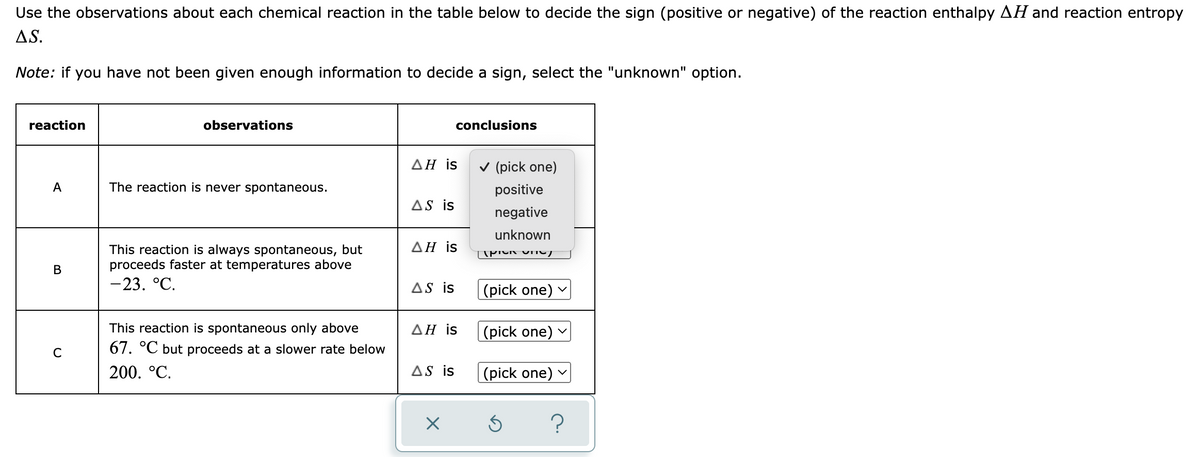Use the observations about each chemical reaction in the table below to decide the sign (positive or negative) of the reaction enthalpy AH and reaction entropy AS. Note: if you have not been given enough information to decide a sign, select the "unknown" option. reaction observations conclusions AH is A The reaction is never spontaneous. AS is AH is B This reaction is always spontaneous, but proceeds faster at temperatures above -23. °C. AS is AH is с This reaction is spontaneous only above 67. °C but proceeds at a slower rate below 200. °C. AS is X ✓ (pick one) positive negative unknown [{PTOR OITOT (pick one) (pick one) v (pick one) S
Use the observations about each chemical reaction in the table below to decide the sign (positive or negative) of the reaction enthalpy AH and reaction entropy AS. Note: if you have not been given enough information to decide a sign, select the "unknown" option. reaction observations conclusions AH is A The reaction is never spontaneous. AS is AH is B This reaction is always spontaneous, but proceeds faster at temperatures above -23. °C. AS is AH is с This reaction is spontaneous only above 67. °C but proceeds at a slower rate below 200. °C. AS is X ✓ (pick one) positive negative unknown [{PTOR OITOT (pick one) (pick one) v (pick one) S
Chemistry for Engineering Students
4th Edition
ISBN:9781337398909
Author:Lawrence S. Brown, Tom Holme
Publisher:Lawrence S. Brown, Tom Holme
Chapter10: Entropy And The Second Law Of Thermodynamics
Section: Chapter Questions
Problem 10.51PAE: 10.51 The combustion of acetylene was used in welder's torches for many years because it produces a...
Related questions
Question
100%

Transcribed Image Text:Use the observations about each chemical reaction in the table below to decide the sign (positive or negative) of the reaction enthalpy AH and reaction entropy
AS.
Note: if you have not been given enough information to decide a sign, select the "unknown" option.
reaction
observations
conclusions
AH is
A
The reaction is never spontaneous.
AS is
ΔΗ is
B
This reaction is always spontaneous, but
proceeds faster at temperatures above
-23. °C.
AS is
AH is
C
This reaction is spontaneous only above
67. °℃ but proceeds at a slower rate below
200. °C.
AS is
X
✓ (pick one)
positive
negative
unknown
TAPICK ON
(pick one)
(pick one)
(pick one)
Ś
?
Expert Solution
This question has been solved!
Explore an expertly crafted, step-by-step solution for a thorough understanding of key concepts.
Step by step
Solved in 2 steps with 2 images

Knowledge Booster
Learn more about
Need a deep-dive on the concept behind this application? Look no further. Learn more about this topic, chemistry and related others by exploring similar questions and additional content below.Recommended textbooks for you

Chemistry for Engineering Students
Chemistry
ISBN:
9781337398909
Author:
Lawrence S. Brown, Tom Holme
Publisher:
Cengage Learning

Chemistry: An Atoms First Approach
Chemistry
ISBN:
9781305079243
Author:
Steven S. Zumdahl, Susan A. Zumdahl
Publisher:
Cengage Learning

Chemistry
Chemistry
ISBN:
9781305957404
Author:
Steven S. Zumdahl, Susan A. Zumdahl, Donald J. DeCoste
Publisher:
Cengage Learning

Chemistry for Engineering Students
Chemistry
ISBN:
9781337398909
Author:
Lawrence S. Brown, Tom Holme
Publisher:
Cengage Learning

Chemistry: An Atoms First Approach
Chemistry
ISBN:
9781305079243
Author:
Steven S. Zumdahl, Susan A. Zumdahl
Publisher:
Cengage Learning

Chemistry
Chemistry
ISBN:
9781305957404
Author:
Steven S. Zumdahl, Susan A. Zumdahl, Donald J. DeCoste
Publisher:
Cengage Learning


Chemistry: The Molecular Science
Chemistry
ISBN:
9781285199047
Author:
John W. Moore, Conrad L. Stanitski
Publisher:
Cengage Learning

Principles of Modern Chemistry
Chemistry
ISBN:
9781305079113
Author:
David W. Oxtoby, H. Pat Gillis, Laurie J. Butler
Publisher:
Cengage Learning